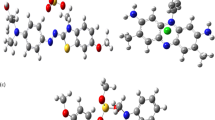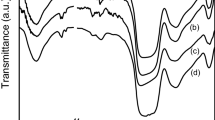Abstract
The paper presents the adsorption of Remazol brilliant blue (RBB) and Disperse orange 25 (DO25) dyes from aqueous solution of the mixture of dyes onto concentrated sulphuric acid-treated red mud (ATRM). First-order derivative spectrophotometric method was developed for the analysis of RBB and DO25 in mixed dye aqueous solution to overcome the limitations arising due to interference in the zero-order spectral method. The optimum conditions to maximize RBB adsorption favoured the adsorption of RBB, and those for DO25 favoured DO25 adsorption from the mixed dye aqueous solutions. Presence of a second dye always inhibited the adsorption of a target dye. The uptake and percentage adsorption of each of the dyes onto ATRM from the aqueous solution of the mixture of dyes decreased considerably with increasing concentrations of the other dye showing the antagonistic effect. Monocomponent Langmuir isotherm fitted the mixed dye adsorption equilibrium data better than the monocomponent Freundlich isotherm. However, monocomponent models are suitable for the fixed concentration of the other dye. Modified Langmuir isotherm model adequately predicted the multi-component adsorption equilibrium data for RBB-DO25-ATRM adsorption system with a good accuracy and is more generic from the application point of view.











Similar content being viewed by others
References
Aksu Z, Acıkel U, Kabasakal E, Tezer S (2002) Equilibrium modelling of individual and simultaneous biosorption of chromium(VI) and nickel(II) onto dried activated sludge. Water Res 36(12):3063–3073
Al-Degs YS, Khraisheh MAM, Allen SJ, Ahmad MN (2009) Adsorption characteristics of reactive dyes in columns of activated carbon. J Hazard Mater 165(1):944–949
Allen SJ, Murray M, Brown P, Flynn O (1994) Peat as an adsorbent for dyestuffs and metals in wastewater. Resour Conserv Recy 11(1):25–39
Altundogan HS, Altundoğan S, TuEmen F, Bildik M (2000) Arsenic removal from aqueous solutions by adsorption on red mud. Waste Manag 20(8):761–767
Bellot JC, Condoret JS (1993) Modelling of liquid chromatography equilibria. Process Biochem 28(6):365–376
Chowdhury S, Chakraborty S, Saha PD (2013) Response surface optimization of a dynamic dye adsorption process: a case study of crystal violet adsorption onto NaOH-modified rice husk. Environ Sci Pollut Res 20:1698–1705
Dabrowski W, Piaseczny G (2000) Numerical simulation of domestic wastewater sewer performance. Lakes Reserv Res Manag 5(2):93–97
Douissa NB, Dridi-Dhaouadi S, Mhenni MF (2014) Study of antagonistic effect in the simultaneous removal of two textile dyes onto cellulose extracted from Posidonia oceanica using derivative spectrophotometric method. J Water Process Eng 2:1–9
El Haddad M, Slimani R, Mamouni R, El Antri S, Lazar S (2013) Removal of two textile dyes from aqueous solutions onto calcined bones. J Assn Arab Univ Basic Appl Sci 14(1):51–59
El-Naas MH, Alhaija MA, Al-Zuhair S (2017) Evaluation of an activated carbon packed bed for the adsorption of phenols from petroleum refinery wastewater. Environ Sci Pollut Res. doi:10.1007/s11356-017-8469-8
Esposito A, Pagnanelli F, Lodi A, Solisio C, Veglio F (2001) Biosorption of heavy metals by Sphaerotilus natans: an equilibrium study at different pH and biomass concentrations. Hydrometallurgy 60(2):129–141
Gandhimathi R, Ramesh ST, Sindhu V, Nidheesh PV (2012) Single and tertiary system dye removal from aqueous solution using bottom ash: kinetic and isotherm studies. Iranica J Energy Environ 3(1):52–62
Gupta VK, Suhas AI, Saini VK (2004) Removal of rhodamine B, fast green, and methylene blue from wastewater using red mud, an aluminum industry waste. Ind Eng Chem Res 43(7):1740–1747
Hassanein TF, Koumanova B (2012) Binary mixture sorption of basic dyes onto wheat straw. Bulg Chem Commun 44:131–138
Karatas M, Argun YA, Argun ME (2012) Decolorization of antraquinonic dye, reactive blue 114 from synthetic wastewater by Fenton process: kinetics and thermodynamics. Ind Eng Chem Res 18(3):1058–1062
Karpińska J (2004) Derivative spectrophotometry—recent applications and directions of developments. Talanta 64(4):801–822
Koyuncu I (2002) Reactive dye removal in dye/salt mixtures by nanofiltration membranes containing vinylsulphone dyes: effects of feed concentration and cross flow velocity. Desalination 143(3):243–253
Liu L, Gao ZY, Su XP, Chen X, Jiang L, Yao JM (2015) Adsorption removal of dyes from single and binary solutions using a cellulose-based bioadsorbent. ACS Sustain Chem Eng 3(3):432–442
Maderova Z, Baldikova E, Pospiskova K, Safarik I, Safarikova M (2016) Removal of dyes by adsorption on magnetically modified activated sludge. Int J Environ Sci Technol 13:1653–1664
Namasivayam C, Arasi DJSE (1997) Removal of congo red from wastewater by adsorption onto waste red mud. Chemosphere 34(2):401–417
Noroozi B, Sorial GA (2013) Applicable models for multi-component adsorption of dyes: a review. J Environ Sci 25(3):419–429
Noroozi B, Sorial GA, Bahrami H, Arami M (2008) Adsorption of binary mixtures of cationic dyes. Dyes Pigments 76(3):784–791
Ojeda CB, Rojas FS (2004) Recent developments in derivative ultraviolet/visible absorption spectrophotometry. Anal Chim Acta 518(1):1–24
Prajapati S S, Najar P A, Tangde V M (2016) Removal of phosphate using red mud: an environmentally hazardous waste by-product of alumina industry. Adv. Phys. Chem. 2016: Article ID 9075206
Qiao S, Hu Q, Haghseresht F, Hu X, Lu GQM (2009) An investigation on the adsorption of acid dyes on bentonite based composite adsorbent. Sep Purif Technol 67(2):218–225
Ratnamala G M (2015) Studies on adsorption of dyes on activated red mud, Ph.D Thesis, National Institute of Technology Karnataka., Surathkal, India
Ratnamala GM, Shetty Vidya K, Srinikethan G (2012) Removal of Remazol brilliant blue dye from dye contaminated water by adsorption using red mud: equilibrium, kinetic and thermodynamic studies. Water Air Soil Pollut 223:6187–6199
Ratnamala GM, Shetty Vidya K, Srinikethan G (2015) Isotherm, kinetics, and process optimization for removal of Remazol Brilliant Blue dye from contaminated water using adsorption on acid-treated red mud. Desalin Water Treat 57(24):11361–11374
Regti A, El Kassimi A, Laamari MR, El Haddad M (2016) Competitive adsorption and optimization of binary mixture of textile dyes: a factorial design analysis. J Assoc Arab Univ Basic Appl Sci. doi:10.1016/j.jaubas.2016.07.005
Sahu MK, Sahu UK, Patel RK (2015) Adsorption of safranin-O dye on CO2 neutralized activated red mud waste: process modelling, analysis and optimization using statistical design. RSC Adv 5(53):42294–42304
Sellaoui L, Bouzid M, Duclaux L, Reinert L, Knani S, Lamine AB (2016a) Binary adsorption isotherms of two ionic liquids and ibuprofen on an activated carbon cloth: simulation and interpretations using statistical and COSMO-RS models. RSC Adv 6(72):67701–67714
Sellaoui L, Depci T, Kul AR, Knani S, Lamine AB (2016b) A new statistical physics model to interpret the binary adsorption isotherms of lead and zinc on activated carbon. J Mol Liq 214:220–230
Tor A, Cengeloglu Y (2006) Removal of congo red from aqueous solution by adsorption onto acid activated red mud. J Hazard Mater 138(2):409–415
Tor A, Danaoglu N, Arslan G, Cengeloglu Y (2009) Removal of fluoride from water by using granular red mud: batch and column studies. J Hazard Mater 164(1):271–278
Turabik M (2008) Adsorption of basic dyes from single and binary component systems onto bentonite: simultaneous analysis of Basic Red 46 and Basic Yellow 28 by first order derivative spectrophotometric analysis method. J Hazard Mater 158:52–64
Wang L (2012) Application of activated carbon derived from ‘waste’ bamboo culms for the adsorption of azo disperse dye: kinetic, equilibrium and thermodynamic studies. J Environ Manag 102:79–87
Author information
Authors and Affiliations
Corresponding author
Additional information
Responsible editor: Guilherme L. Dotto
Rights and permissions
About this article
Cite this article
Gadigayya Mavinkattimath, R., Shetty Kodialbail, V. & Govindan, S. Simultaneous adsorption of Remazol brilliant blue and Disperse orange dyes on red mud and isotherms for the mixed dye system. Environ Sci Pollut Res 24, 18912–18925 (2017). https://doi.org/10.1007/s11356-017-9278-9
Received:
Accepted:
Published:
Issue Date:
DOI: https://doi.org/10.1007/s11356-017-9278-9




